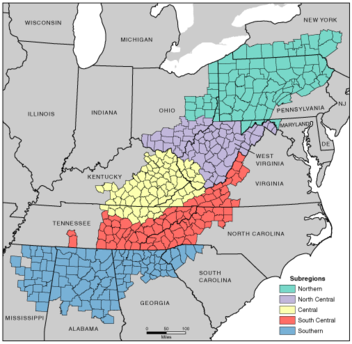 Global Information
Global InformationSocial and economic stratification in Appalachia information


Appalachia is a geographic region of the Eastern United States. Home to over 25 million people, the region includes mountainous areas of 13 states: Mississippi, Alabama, Pennsylvania, New York, Georgia, South Carolina, North Carolina, Tennessee, Virginia, Kentucky, Ohio, Maryland, as well as the entirety of West Virginia.[1]
Appalachia is often divided into three subregions: Southern Appalachia (portions of Georgia, Alabama, Mississippi, North and South Carolina, and Tennessee), Central Appalachia (portions of Kentucky, Southern West Virginia, Southern and Southeastern Ohio, Virginia, and Tennessee), and Northern Appalachia (parts of New York, Pennsylvania, Northern West Virginia, Maryland, and Northeastern Ohio).[1] Further divisions can also be made, distinguishing Northern from North Central and Southern from South Central Appalachia.[2] Though all areas of Appalachia face the challenges of rural poverty, some elements (particularly those relating to industry and natural resource extraction) are unique to each subregion. Central Appalachians, for example, experience the most severe poverty, which is partially due to the area's isolation from urban growth centers.[3] The Appalachian region holds 423 counties and covers 206,000 square miles.[4]
The area's rugged terrain and isolation from urban centers has also resulted in a distinct regional culture. Many natives of the region have a distinct pride for their Appalachian heritage regardless of financial status. Outsiders often hold incorrect and overgeneralized beliefs about the area and its inhabitants. These misperceptions, and their relationship to the culture and folklore of this near-isolated area, greatly impact the region's development.[1]
Commerce within the region expanded widely in the 19th century with the advent of modern industries like agriculture, coal-mining, and logging. Many Appalachians sold their rights to land and minerals to large corporations, to the extent that ninety-nine percent of the residents control less than half of the land. Thus, though the area has a wealth of natural resources, its inhabitants are often poor. In addition, decreased levels of education and a lack of public infrastructure (such as highways, developed cities, businesses, and medical services) has perpetuated the region's poor economic standing.[1]
- ^ a b c d Hurst, Charles. (1992). Inequality in Appalachia. Social Inequality: Forms, Causes, and Consequences, 6th Edition. Pearson Education. pp 62-68.
- ^ "Subregions in Appalachia". Appalachian Regional Commission. Retrieved 2021-03-08.
- ^ Tickamyer, Ann; Cynthia, Duncan. (1990). Poverty and Opportunity Structure in Rural America. Annual Review of Sociology. 16:67-86. Retrieved November 28 from Academic Search Premier.
- ^ "About the Appalachain Region". Appalachian Regional Commission.